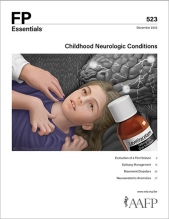
This clinical content conforms to AAFP criteria for CME.
Most movement disorders in children are hyperkinetic. The most common type is tic disorders, which can involve motor and phonic tics and are classified as simple or complex. Motor or phonic tics that persist for more than 1 year are defined as persistent (chronic) tic disorder. Tourette syndrome can be diagnosed if a child has multiple motor tics and at least one phonic tic for more than 1 year with onset before age 18 years. Children with Tourette syndrome may have symptoms of attention-deficit/hyperactivity disorder, obsessive-compulsive disorder, depression, or behavioral disorders. Chorea can be seen as a symptom of rheumatic fever (Sydenham chorea), in children with a history of kernicterus, and in dyskinetic cerebral palsy. Chorea also may be part of an underlying metabolic or genetic condition. Dystonia is characterized by repetitive contortions and posturing of the limbs and body. It can be isolated or part of an underlying neurologic condition. Tremor can occur as a manifestation of essential tremor or can be an enhanced physiologic tremor exacerbated by drugs, illness, or stimulants. Ataxia most often is seen as a postinfectious or postvaccination acute cerebellar ataxia. Progressive ataxias are consistent with an underlying metabolic or genetic condition. Transient and developmental movement disorders include benign neonatal sleep myoclonus, jitteriness in neonates, shuddering, and stereotypies.
Case 3. SA is an 8-year-old boy with attention-deficit/hyperactivity disorder who is brought to your office for a well-child visit. When discussing school, his parents mention that SA has been told to leave the classroom because of disruptive behaviors several times. On further questioning, his parents say SA has been making frequent whistling noises in class, particularly during tests. As SA discusses these noises, he begins making whistling sounds and has repetitive facial twitching. His parents note that SA has had episodes of face twitching and repeated eye blinking since age 6 years.
Subscribe
From $350- Immediate, unlimited access to FP Essentials content
- 60 CME credits/year
- AAFP app access
- Print delivery available
Edition Access
$44- Immediate, unlimited access to this edition's content
- 5 CME credits
- AAFP app access
- Print delivery available
